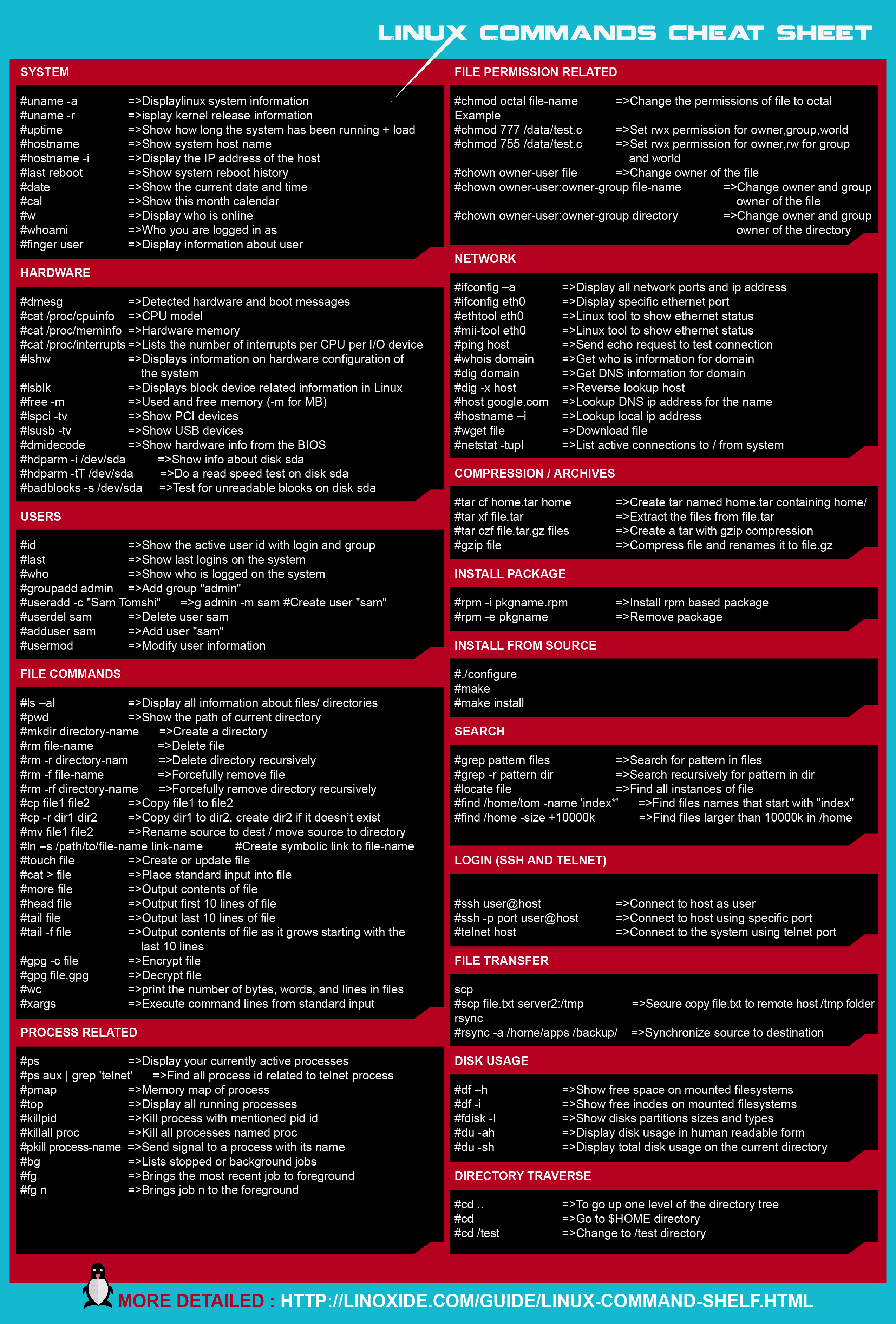

- #Linux command cheat sheet install
- #Linux command cheat sheet update
- #Linux command cheat sheet upgrade
- #Linux command cheat sheet full
- #Linux command cheat sheet Pc
It is like posting those periodic table charts or maps on the wall, for quick reference and for memorizing them.Įnough talking.
#Linux command cheat sheet Pc
Specially if you have a desktop PC and your desktop is visible most of the time. But cheat sheets wallpaper could come handy. I had created it long back when I started working on Vi.īut cheat sheets as wallpaper!! Hmm! Honestly, I don’t even see enough of my desktop these days. In an earlier article, I did provide a Vi cheat sheet download. I do create cheat sheets or better to call it as quick reference guides, whenever I start working on something unfamiliar.

If you ask me, I am a fan of cheat sheets but not as wallpapers. I hope this will help you to perform your day-to-day system administration task.Looking for some cool Linux wallpapers to download? What could be cooler for a Linux user than command line? How about using desktop backgrounds that also double up as cheat sheets? After all Linux command cheat sheets often come handy. The above examples are the most commonly used Linux commands. Zip filename.zip file1.txt file2.txt file3.txt Tar, Zip, and Unzip are the most popular command-line utility in Linux used to compress and uncompress files and directories. List all available packages on RPM-based distributions List all installed packages on RPM-based distributions
#Linux command cheat sheet update
Update all system packages to the latest version on RPM-based distributions Remove a package on RPM-based distributions
#Linux command cheat sheet install
Install the package on RPM-based distributions Remove all unwanted packages on Debian based distributions
#Linux command cheat sheet upgrade
Upgrade a specific package on Debian based distributions Update the repository on Debian based distributions Get a list of all packages on Debian based distributions Remove a package on Debian based distributions Install the package on Debian based distributions In this section, we will show a list of all commands to install, remove and manage packages in Linux. Test for unreadable blocks on disk /dev/sda Perform a read speed test on disk /dev/sda CommandĬreate a new partition on /dev/sda deviceĬheck and repair a filesystem for any errorĭisplay free space of mounted file systemĭisplay the size of your current directory In this section, we will show you disk management commands including, add and remove partitions, mount a partition, check disk space, format partition, etc. List all files opened by running processes Manage and display all processes in realtimeĭisplay processes in the tree-like diagram Process Management helps you to monitor and manage your application. The application will get a process ID or PID. CommandĬhange the user account information including, group, home directory, shell, expiration dateĭisplay information of the last login user In that case, user and group management allows you to complete your objectives. In some cases, two or more users may need to share access to system resources like files and directories. So multiple users can log in to the system and work on the system at the same time. Remove the execution permission of any fileĬhange the owner and group ownership of a fileĬhange the owner and group ownership of the directory and all sub-directories
#Linux command cheat sheet full
Perform a reverse lookup of an IP addressĪssign full(read, write, and execute) permission to everyoneĪssign full permission to the directory and all sub-directoriesĪssign full permission to the owner, and read and write permission to group and others List all IP addresses and network interfacesĪdd a temporary IP address to interface eth1ĭisplay more information about any domain List all files and directories including, hidden files and other information like permissions, size, and ownerĬhange the directory to the home directoryĬombine two files named file1 and file2 and store the output in a new file file3 List all files and directories in the current working directory Get system information including, operating system, kernel, and release versionĭisplay the IP and Mac Address of the systemĭisplay currently logged in users in the systemĭisplay free and used memory in the system In this section, we will show you some basic Linux commands with examples. I have prepared this Linux Commands Cheat Sheet as quick reference for both experienced and basic users. This cheat sheet offers a set of commands that you can use for quick reference. Only a very small subset of those commands are used on a day-to-day basis. The good news is that you don't need to remember each command.

Remembering every command is not possible and it can be quite daunting for a novice user. There are hundreds – possibly thousands – commands available in Linux.


 0 kommentar(er)
0 kommentar(er)
